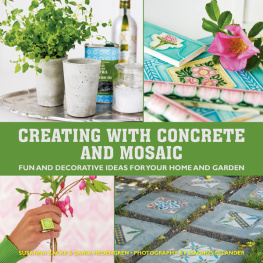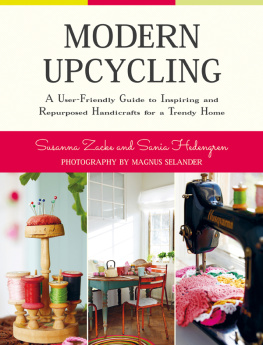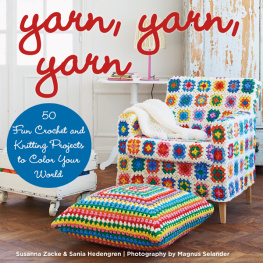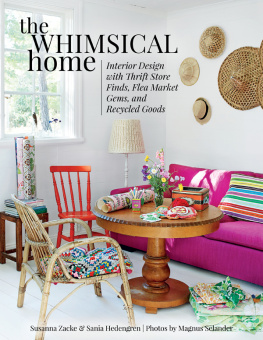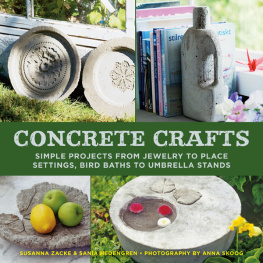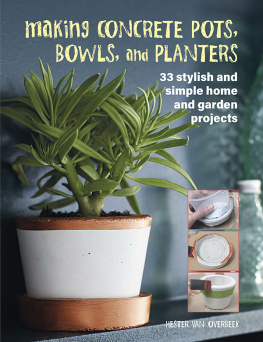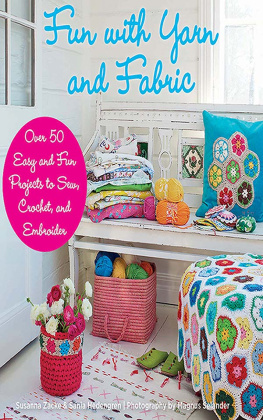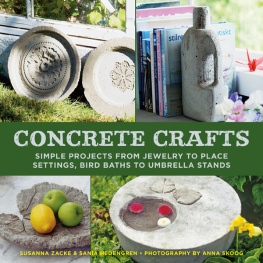Copyright 2010 by Susanna Zacke and Sania Hedengren
English Translation 2015 by Skyhorse Publishing
First published in 2010 as Skapa med Betong & Mosaic by Sania Hedengren and Susanna Zacke, Bokfrlaget Semic, Sundbyberg, Sweden
Photography by Magnus Selander
Graphic design by Marianne Lillir
All Rights Reserved. No part of this book may be reproduced in any manner without the express written consent of the publisher, except in the case of brief excerpts in critical reviews or articles. All inquiries should be addressed to Skyhorse Publishing, 307 West 36th Street, 11th Floor, New York, NY 10018.
Skyhorse Publishing books may be purchased in bulk at special discounts for sales promotion, corporate gifts, fund-raising, or educational purposes. Special editions can also be created to specifications. For details, contact the Special Sales Department, Skyhorse Publishing, 307 West 36th Street, 11th Floor, New York, NY 10018 or .
Skyhorse and Skyhorse Publishing are registered trademarks of Skyhorse Publishing, Inc., a Delaware corporation.
www.skyhorsepublishing.com
10 9 8 7 6 5 4 3 2 1
Library of Congress Cataloging-in-Publication Data is available on file.
Cover design by Eric Kang
Print ISBN: 978-1-63220-366-3
Ebook ISBN 978-1-63450-108-8
Printed in China

Susanna likes pink and red
Sania likes yellow and green
WE WOULD LIKE TO THANK EVERYONE WHO HAS BEEN INVOLVED WITH THIS BOOK.
Our helpful husbands, Michael and P-G, who proofread, searched for typefaces, carried things, and fixed a lot of other practical items.
Finja Betong , who provided us with concrete!
Raja, Tabbouli House, Franska Kakelbutiken (the French tile company), and Panduro craft store, who lent us props.
Our children, Pontus, Nicole, Elin, Lisa, and Hanna, who endured the mess at home during photo shoots.
Everyone who owns our first book, Concrete Crafts . Because there are so many of you, we decided to create another book.
Eva and Annelie (and everyone else) at our favorite Swedish publisher, Semic. Thank you, as always, for the great collaboration!
Last but not least, our photographer Magnus Selander, who creates such beautiful images of our work.
He manages to work with impossible angles, our constant demands, and difficult lighting to produce the best images.
Nothing is impossible for this man!
Contents
Creating with Concrete & Mosaic
Here it is, our second book about concrete, an awesome material that we never tire of. If you already read our first book, youll find many new casting ideas, and if youre a beginner, you might as well start here. We just want to continue sharing our ideas and the joy we experience from creating things with concrete.
Its not difficult to cast your own creations. You can easily make professional-looking items from concrete in a day. In this book, we have also chosen to use tiles, mosaic, and crushed porcelain in some of the projects. They are both super fun and very easy to use and incredibly beautiful when combined with concrete. Some projects are purely concrete based, others are completely mosaic based, and some are a combination of both.
To cast in concrete you simply mix fine concrete with water and then pour it into molds of various shapes and sizes. The main thing is to use your imagination when looking for molds. An old rubber boot or a cake tin are examples of molds that you probably already have at home. You can even build your own molds if you want to make a tabletop, for example. The variations are endless.
You can add mosaics to almost anything. The old table in the garage or a thrift store mirror are given a new spark of life and a unique look if you dress them in mosaic. Tile adhesive and grout is all you needand the mosaic of course. The availability of tiles and mosaic is enormous; beautiful Moroccan ceramic tiles, antique tiles from India, or white modern circular mosaics are all examples of things we like. You can also create a great look by crushing some old porcelain and using the shards to make mosaics.
This book contains a wide variety of projects from the unique mosaic ring to concrete stairs, and everything in-between. Super easy or a bit more advanced, there is something for everyone here. So be inspired and let your creativity flow, and good luck!
Sania and Susanna

A guide to
CONCRETE
WHAT IS CONCRETE?
Concrete consists of 80 percent ballast rock, which is comprised of sand, stone, and gravel; 14 percent cement, which consists of heated and ground limestone; and 6 percent water. Therefore, concrete is a natural material that is eco-friendly, useful, and long lasting. With a long history of usage, concrete is one of the worlds most important building materials. Ancient buildings, such as amphitheatres, bridges, and houses, that have been built using concrete have been around since the second or third century. The fine concrete that we have used is usually quite smooth because it contains small stones that are a maximum of 1/8 inches (4 mm) in size. If you prefer concrete that is even smoother, you can find various concrete repair products at your local home improvement center.
MOLDS
Your choice of mold is the most important thing when working with concrete, as this is what delivers your result. This part requires a bit of creative thinking. Plastic is a great choice because its elastic and has a smooth surface that can be easily removed. However, other materials such as strong cardboard, wood, or rubber and silicon also work well. If you brush the inside of the mold with vegetable oil, the concrete will be easier to release from the mold. Buckets, plastic pots, and old packaging are examples of good, cheap molds.
Sometimes you might have to cut the mold to release the concrete, so the cheaper the material, the better. You can even get a little more creativean old rubber boot, a plastic ball, or a silicon muffin tray can make unique and wonderful creations. Keep your eyes open for unusual shapes in thrift stores and yard sales, as these places can be a real goldmine for cheap molds!
For tabletops and other furniture you will need to make a frame from particleboard and joists. An alternative to particleboard is form plywood, a smooth water-resistant board that is made especially for casting in concrete. Because they are waterproof, they can be reused. It is a bit more expensive, but can be a worthy investment if you plan to make more advanced projects. Form plywood is made so that it does not stick to the concrete. The benefit of building your own mold is that you can customize it to your desired size.
REINFORCEMENT
Reinforcing the concrete is necessary when making larger pieces. A tabletop, for example, needs to be strengthened so it doesnt break. Reinforcing also makes the concrete more resistant to freezing temperatures. Its not as complicated as it sounds. To reinforce concrete, you can use rebar, reinforcement mesh, chicken wire, or galvanized wire mesh. The latter two are softer and easy to cut using a pair of pliers. If you use reinforcing bars or mesh, it will be cut at the home improvement center, where the tools required are available. If you are making larger projects, we suggest you ask an expert for more advice on reinforcing to achieve the right dimensions.
Next page
